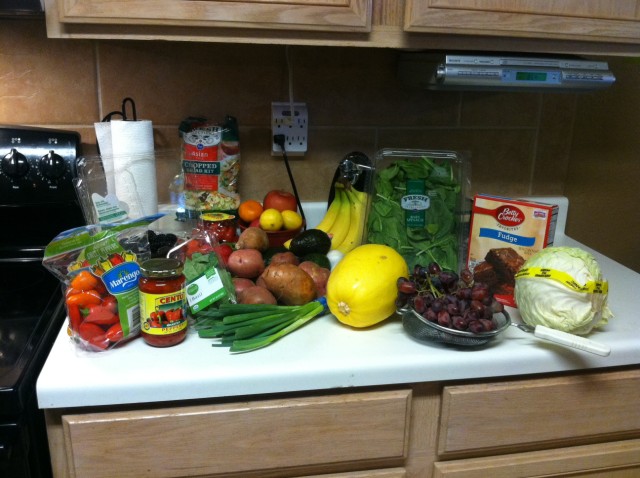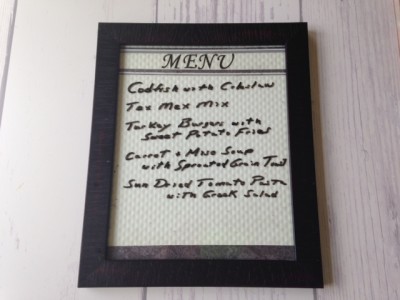Healthy grocery shopping doesn’t have to be time consuming or confusing.
With just a few easy tips you will be off to a great start. This picture shows what most of my kitchen counter looks like when I get home from the grocery store.

You’ll notice that the items shown reflect the 80/20 rule. That’s why I went ahead and included the box of brownies (they’re for my husband of course).
Now on to a more serious note. Here are the 4 rules I use for healthy grocery shopping.
1. Begin at home by gathering healthy recipes.
The process of healthy grocery shopping begins at home. Begin by gathering healthy recipes and keeping them in a “Healthy Recipe” binder.
This keeps them separate them from the recipes you’ve had all of those years before you chose to eat healthy. It also insures that you won’t be tempted to focus your meal planning around what you may have been accustomed to, If some of the recipes you have on hand are healthy, transfer them over to your new “Healthy Recipe” binder.
That doesn’t mean you have to throw everything else away. Just make sure you that you use those recipes sparingly (like in the 80/20 rule I mentioned above).
Make a menu plan and keep it handy for easy reference the rest of the week. This will help when you’re trying to decide what to make for a meal. From this menu, make a grocery list and determine to stick to it.
2. Do the major part of your grocery shopping around the perimeter of the grocery store.
The perimeter of the grocery store is where you will find most of your whole foods that are either fresh or frozen. In these areas you will find a minimal amount of processed foods, foods that have been altered, and foods with additives.
Whether or not you should buy fresh or frozen is really up for debate. Buying fresh usually has great taste and if locally grown it is packed full of healthy nutrients. But if it’s shipped from outside of your local area, chances are it was picked green and may be lacking some nutrients.
When it’s necessary to go into the aisles, I always read labels. If an item has high fructose corn syrup, hydrogenated oils (otherwise known as trans fats), and a whole list of ingredients I can’t pronounce, I put it back.
3. Spend most of your time in the produce section.
The produce section is usually the one that you encounter first when you begin shopping. Too often we are in a hurry to complete our shopping and may feel we’re spending too much time in this section, not leaving enough time for other areas. But I have found that once I am finished with the produce section, the rest of my shopping trip goes rather quickly.
4. Shop by color.
The color of fruits and vegetables is a great indicator of the vitamins, minerals, and phyto(plant)nutrients they contain. These nutrients are essential to our overall health, including antiinflammatories and antioxidants.
Red foods are known for a nutrient that stands at bay around your cells to protect them.
Purple foods are known for a nutrient that fights viruses.
Green foods are known for cleaning out your cells to keep them healthy.
A Little Something Extra:
 This idea was given to me by my daughter. I used an 8×11 photo frame, some background paper and some sticky letters to make this handy way of displaying my week’s menu.
This idea was given to me by my daughter. I used an 8×11 photo frame, some background paper and some sticky letters to make this handy way of displaying my week’s menu.
I use a dry erase marker to change it up every week. And I and keep it on the kitchen counter so I’m never left wondering, “Now, what did I have planned for dinners this week?”
I hope all of this helps you with your journey for eating healthy. If you have a shopping tip that has helped you, please leave a note in the comments!

